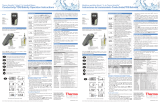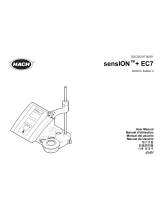
STARTER 300C Portable Conductivity Meter EN-1
TABLE OF CONTENTS
1 INTRODUCTION ................................................................... 1
1.1 Definition of Signal Warnings and Symbols ...................................... 1
1.2 Safety Precautions ............................................................................ 2
1.3 Display and controls .......................................................................... 2
2 INSTALLATION ..................................................................... 4
2.1 Package contents .............................................................................. 4
2.2 Installing the batteries ....................................................................... 5
2.3 Installing the electrode clip ................................................................ 5
2.4 Installing the IP54 cover .................................................................... 5
2.5 Integrated stand for table top use ..................................................... 6
3 SETUP ................................................................................... 6
3.1 Set temperature unit .......................................................................... 6
3.2 Set MTC temperature value .............................................................. 6
3.3 Set calibration standard .................................................................... 7
3.4 Set temperature correction coefficient .............................................. 7
3.5 Set TDS factor ................................................................................... 7
4 STARTER 300C OPERATION .............................................. 8
4.1 Calibration ......................................................................................... 8
4.1.1 Selecting a standard ................................................................... 8
4.1.2 Performing a calibration ............................................................. 8
4.2 Sample measurement ....................................................................... 9
4.3 TDS measurement ............................................................................ 9
4.4 Using the memory ........................................................................... 13
4.4.1 Storing a reading ...................................................................... 13
4.4.2 Recalling from memory ............................................................ 13
4.4.3 Clearing the memory ................................................................ 13
5 MAINTENANCE .................................................................. 14
5.1 Error message .................................................................................. 11
5.2 Meter maintenance........................................................................... 11
5.3 Self diagnosis ................................................................................... 11
5.4 Recover factory settings ................................................................... 11
6 TECHNICAL DATA ............................................................. 15
6.1 Specifications ................................................................................ 15
6.2 Compliance ..................................................................................... 16
7 APPENDIX .......................................................................... 14
7.1 Conductivity standards .................................................................... 14
7.2 Examples of temperature coefficients (α-value).............................. 17
7.3 Conductivity to TDS conversion factors .......................................... 17

























